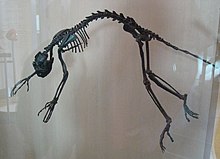Pronycticebus was a genus of adapiformes primates that lived during the middle to middle late Eocene. It is represented by two species, Pronycticebus gaudryi and Pronycticebus neglectus, of which an almost complete specimen was found in Germany, and the Quercy Phosphorites Formation of France.

Smilodectes is a genus of adapiform primate that lived in North America during the middle Eocene. It possesses a post-orbital bar and grasping thumbs and toes. Smilodectes has a small cranium size and the foramen magnum was located at the back of the skull, on the occipital bone.

Notharctinae is an extinct subfamily of primates that were common in North America during the early and middle Eocene. The six genera that make up the group contain species that are among the most primitive of the adapiform group, which is one of the most primitive groups of primates. The evolutionary history of this subfamily has been comparatively well documented and has been used to argue for evolutionary gradualism. Though it is generally accepted that adapiforms gave rise to modern day lemurs and lorises, it is not currently known which branch of Adapiformes these living species are most closely related to. Notharctines became extinct in the middle Eocene, most likely because of a combination of factors including climatic change and competition with other North American primates.
Hesperolemur is a genus of adapiform primate that lived in the middle Eocene of southern California. It is an immigrant taxa which appears to be most closely related to the earlier European forms of Cantius. It was approximately 4.5 kilograms (9.9 lb) in weight and was the last surviving notharctine species, probably because of its position in the refugia that existed in southern California during the climate deterioration at the end of the middle Eocene. There are no later taxa that appear to have derived from Hesperolemur.

Pelycodus is an extinct genus of adapiform primate that lived during the early Eocene (Wasatchian) period in Europe and North America, particularly Wyoming and New Mexico. It is very closely related to Cantius and may even be its subgenus. It may also have given rise to the Middle Eocene Uintan primate Hesperolemur, although this is controversial. From mass estimates based on the first molar, the two species, P. jarrovii and P. danielsae, weighed 4.5 kg and 6.3 kg respectively and were frugivores with an arboreal, quadrupedal locomotion.
Adapoides is a genus of adapiform primate dating to the Middle Eocene in Asia. It is represented by one species, Adapoides troglodytes.

Cercamoniinae is a subfamily within the extinct primate family Notharctidae primarily found in Europe, although a few genera have been found in North America and Africa.

Europolemur is a genus of adapiform primates that lived in Europe during the middle Eocene.
Anchomomys is a genus of adapiform primate that lived in Europe and Africa during the middle Eocene.
Mahgarita stevensi is a genus of adapiform primate that lived in North America during the late Eocene. Fossils of the genus were found in the Duchesnean Laredo and Devil's Graveyard Formations of Texas.
Adapinae is a subfamily within the extinct primate family Adapidae primarily found in Europe until the end of the Eocene. They are thought to have originated in Asia.
Aframonius is a genus of adapiform primate that lived in Africa during the late Eocene or early Oligocene. Fossils of the genus were found in the Jebel Qatrani Formation of Egypt.

Caenopithecus is a genus of adapiform primate that lived in Europe during the middle Eocene.
Copelemur is a genus of adapiform primate that lived in North America during the early Eocene.
Hoanghonius is a genus of adapiform primate that lived in Asia during the middle Eocene.
Rencunius is a genus of adapiform primate that lived in Asia during the late middle Eocene. It includes the species Rencunius zhoui.
Wailekia is a genus of adapiform primate that lived in Asia during the late Eocene.
Shizarodon is a genus of primate related to lemuriforms that lived in Oman during the early Oligocene.
Cryptadapis is a genus of adapiform primate that lived in Europe during the late Eocene.

Leptadapis is a genus of adapiform primate that lived in Europe during the middle Eocene. Fossils of the genus have been found in the Escanilla Formation of Spain and Egerkingen in Switzerland.










